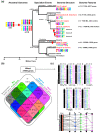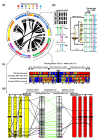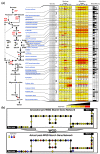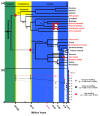RNA-seq in grain unveils fate of neo- and paleopolyploidization events in bread wheat (Triticum aestivum L.)
- PMID: 22136458
- PMCID: PMC3334614
- DOI: 10.1186/gb-2011-12-12-r119
RNA-seq in grain unveils fate of neo- and paleopolyploidization events in bread wheat (Triticum aestivum L.)
Abstract
Background: Whole genome duplication is a common evolutionary event in plants. Bread wheat (Triticum aestivum L.) is a good model to investigate the impact of paleo- and neoduplications on the organization and function of modern plant genomes.
Results: We performed an RNA sequencing-based inference of the grain filling gene network in bread wheat and identified a set of 37,695 non-redundant sequence clusters, which is an unprecedented resolution corresponding to an estimated half of the wheat genome unigene repertoire. Using the Brachypodium distachyon genome as a reference for the Triticeae, we classified gene clusters into orthologous, paralogous, and homoeologous relationships. Based on this wheat gene evolutionary classification, older duplicated copies (dating back 50 to 70 million years) exhibit more than 80% gene loss and expression divergence while recent duplicates (dating back 1.5 to 3 million years) show only 54% gene loss and 36 to 49% expression divergence.
Conclusions: We suggest that structural shuffling due to duplicated gene loss is a rapid process, whereas functional shuffling due to neo- and/or subfunctionalization of duplicates is a longer process, and that both shuffling mechanisms drive functional redundancy erosion. We conclude that, as a result of these mechanisms, half the gene duplicates in plants are structurally and functionally altered within 10 million years of evolution, and the diploidization process is completed after 45 to 50 million years following polyploidization.
Figures





Similar articles
-
Intraspecific sequence comparisons reveal similar rates of non-collinear gene insertion in the B and D genomes of bread wheat.BMC Plant Biol. 2012 Aug 30;12:155. doi: 10.1186/1471-2229-12-155. BMC Plant Biol. 2012. PMID: 22935214 Free PMC article.
-
Comparative analysis of syntenic genes in grass genomes reveals accelerated rates of gene structure and coding sequence evolution in polyploid wheat.Plant Physiol. 2013 Jan;161(1):252-65. doi: 10.1104/pp.112.205161. Epub 2012 Nov 1. Plant Physiol. 2013. PMID: 23124323 Free PMC article.
-
Relationship between homoeologous regulatory and structural genes in allopolyploid genome - a case study in bread wheat.BMC Plant Biol. 2008 Aug 13;8:88. doi: 10.1186/1471-2229-8-88. BMC Plant Biol. 2008. PMID: 18700978 Free PMC article.
-
Organization and evolution of the chalcone synthase gene family in bread wheat and relative species.BMC Genet. 2019 Mar 18;20(Suppl 1):30. doi: 10.1186/s12863-019-0727-y. BMC Genet. 2019. PMID: 30885129 Free PMC article.
-
The Battle to Sequence the Bread Wheat Genome: A Tale of the Three Kingdoms.Genomics Proteomics Bioinformatics. 2020 Jun;18(3):221-229. doi: 10.1016/j.gpb.2019.09.005. Epub 2020 Jun 17. Genomics Proteomics Bioinformatics. 2020. PMID: 32561470 Free PMC article. Review.
Cited by
-
RNA-Seq and iTRAQ Reveal the Dwarfing Mechanism of Dwarf Polish Wheat (Triticum polonicum L.).Int J Biol Sci. 2016 Apr 8;12(6):653-66. doi: 10.7150/ijbs.14577. eCollection 2016. Int J Biol Sci. 2016. PMID: 27194943 Free PMC article.
-
Karyotype Reorganization in Wheat-Rye Hybrids Obtained via Unreduced Gametes: Is There a Limit to the Chromosome Number in Triticale?Plants (Basel). 2021 Sep 29;10(10):2052. doi: 10.3390/plants10102052. Plants (Basel). 2021. PMID: 34685861 Free PMC article.
-
Comparative transcript profiling of the fertile and sterile flower buds of pol CMS in B. napus.BMC Genomics. 2014 Apr 3;15:258. doi: 10.1186/1471-2164-15-258. BMC Genomics. 2014. PMID: 24707970 Free PMC article.
-
Dual RNA-seq transcriptional analysis of wheat roots colonized by Azospirillum brasilense reveals up-regulation of nutrient acquisition and cell cycle genes.BMC Genomics. 2014 May 16;15(1):378. doi: 10.1186/1471-2164-15-378. BMC Genomics. 2014. PMID: 24886190 Free PMC article.
-
Transcriptomic Profiles Reveal the Interactions of Cd/Zn in Dwarf Polish Wheat (Triticum polonicum L.) Roots.Front Physiol. 2017 Mar 23;8:168. doi: 10.3389/fphys.2017.00168. eCollection 2017. Front Physiol. 2017. PMID: 28386232 Free PMC article.
References
-
- Ohno S. Evolution by Gene Duplication. Berlin: Springer-Verlag; 1970. p. 160.
-
- Salse J, Abrouk M, Bolot S, Guilhot N, Courcelle E, Faraut T, Waugh R, Close TJ, Messing J, Feuillet C. Reconstruction of monocotelydoneous proto-chromosomes reveals faster evolution in plants than in animals. Proc Natl Acad Sci USA. 2009;106:14908–14913. doi: 10.1073/pnas.0902350106. - DOI - PMC - PubMed
Publication types
MeSH terms
LinkOut - more resources
Full Text Sources
Molecular Biology Databases

